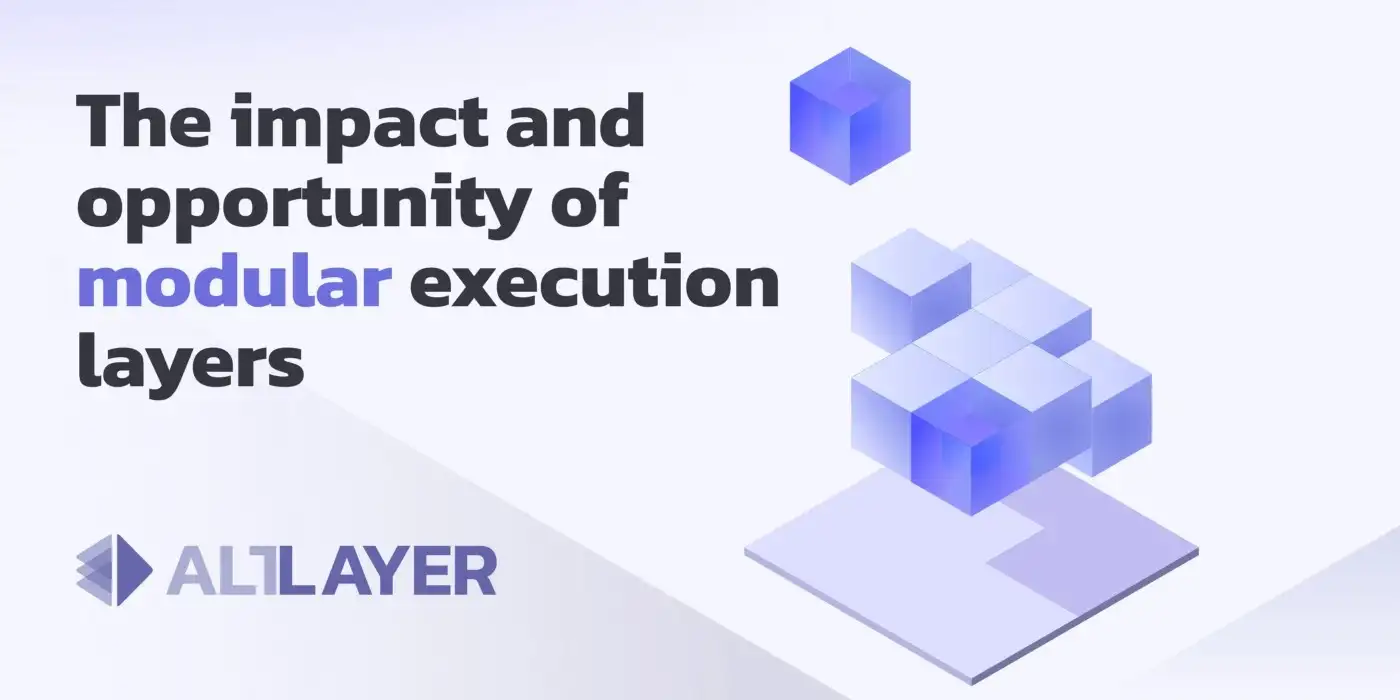Web3 use cases demonstrating the impact of modular blockchains are proving that this design could be a more sustainable architectural choice for builders everywhere. Differing from monolithic blockchains, which process everything from A-Z on a single network — users and developers are seeing the benefits of ‘delegation’, an approach that a modular computational layer offers. But, how has modularity done so far? Let’s dig deeper and find out how they’ve impacted the space and why they offer a better alternative to existing chain architectures.
Web3 用例表明,模块化区块链的影响正在证明这种设计对于各地的构建者来说可能是一种更可持续的架构选择。与在单个网络上处理所有的内容的整体区块链不同,用户和开发人员正在看到“委托”的好处,这是一种模块化计算层提供的方法。但是,到目前为止,模块化是如何实现的?让我们深入挖掘一下,看看它们是如何影响这个领域的,以及为什么它们可以提供比现有链架构更好的替代方案。
首先:单片链与模块化链 (First things first: Monolithic vs. Modular Chains)
Before we assess the impact, let us first understand the two major types of chain architectures prevalent today, and how they’re different from one another.
在我们评估影响之前,让我们首先了解当今流行的两种主要类型的链架构,以及其之间的区别。
First off, we have monolithic chains, which refer to a network where nodes execute user transactions (execution), reach consensus on the resulting state (consensus), update the resulting global state (settlement), store and guarantee transaction data (data availability) — all on the same network. Given that the entire transaction lifecycle is handled within the same network, a monolithic system is highly unscalable.
首先,我们有单片链,它指的是一个网络,其中节点执行用户交易(执行 execution),就结果状态达成共识(共识 consensus),更新结果全局状态(结算 settlement),存储和保证交易数据(数据可用性 data availability) — 全 在同一个网络上。鉴于整个交易生命周期都在同一个网络中处理,单片系统是高度不可扩展的。
An alternative and popular design philosophy is that of modularization, which posits the idea of a separate execution layer detached from settlement and data availability layers for better scalability. As monolithic chains adopt the modular architecture, they have started to mostly handle settlement, consensus and the DA stack, while execution has moved out of the chain.
另一种流行的设计理念是模块化,它提出了一个独立的执行层与结算和数据可用性层分离的想法,以实现更好的可扩展性。由于单片链采用模块化架构,它们开始主要处理结算、共识和 DA 堆栈,而执行已移出链。
This phenomenon of execution moving out of a monolithic chain first started on Ethereum with the launch of execution layers such as StarkNet, Arbitrum and Optimism and now is slowly permeating the broader L1 space. These execution layers are more scalable, economical and create less negative externalities for end users compared to monolithic chains. With the need for an open, decentralized and universal execution hub growing, modular designed blockchains are here to stay.
这种执行从单片链中移出的现象首先在以太坊上开始,随着 StarkNet、Arbitrum 和 Optimism 等执行层的推出,现在正慢慢渗透到更广泛的 L1 空间。与整体链相比,这些执行层更具可扩展性、更经济,并且对最终用户产生的负面外部影响更小。随着对开放、分散和通用执行中心的需求不断增长,模块化设计的区块链将继续存在。
Monolithic vs Modular Blockchain Architecture 单体与模块化区块链架构
模块化设计的好处 (The benefits of a modular design)
With execution moving out of the chain, developers are no longer constrained by the many restrictions imposed by the monolithic architecture of legacy chains, resulting in the development of different types of execution layers depending on the underlying tech (ZK or optimistic execution), the runtime (EVM, WASM, etc.), the purpose of the execution layer (general purpose or application-specific) and the underlying network used for DA and settlement.
随着执行移出链,开发人员不再受遗留链单片架构强加的许多限制的约束,导致根据底层技术(ZK 或乐观执行)、运行时开发不同类型的执行层(EVM、WASM等),执行层的用途(通用或特定应用)和用于DA和结算的底层网络(的优化)。
As a result, one can imagine taking different combinations of these traits to produce new execution layers. For example, one could build an execution layer running the Solana VM but secured by an EVM chain. This would allow an EVM chain to attract Solana developers as it will become easier to port a Solana-based application. Vice versa, a separate execution layer is also an easy way to allow developers to bring EVM to a non-EVM chain.
因此,可以想象采用这些特征的不同组合来产生新的执行层。例如,可以构建一个运行 Solana VM 但由 EVM 链保护的执行层。这将使 EVM 链能够吸引 Solana 开发人员,因为移植基于 Solana 的应用将变得更加容易。反之亦然,单独的执行层也是允许开发人员将 EVM 引入非 EVM 链的简单方法。
A simple taxonomy of execution layers 执行层的简单分类
当前的执行层是否有效?(Are current execution layers effective?)
Over the last year or so, we have seen a great number of execution layers being built across different legacy L1 ecosystems resulting in a very fragmented execution space. This fragmented execution space has created several pain points for developers. To start with, existing tools to launch execution layers are often tied to specific chains leaving little to no room for flexibility to dApp developers to move to a new base chain. Developers looking to build a new execution layer also have to deal with the heterogeneity which is particularly difficult to navigate due to the lack of a single unifying development framework. Moreover, many devs as well as non-devs looking to spin an execution layer prefer to have a simple dashboard as opposed to low-level SDKs.
在过去一年左右的时间里,我们看到在不同的遗留 L1 生态系统中构建了大量执行层,导致执行空间非常分散。这种分散的执行空间给开发人员带来了几个痛点。首先,用于启动执行层的现有工具通常与特定链相关联,几乎没有为 dApp 开发人员转移到新基础链的灵活性留出空间。希望构建新执行层的开发人员还必须处理异构性,由于缺乏单一的统一开发框架,这种异构性特别难以驾驭。此外,许多希望转换执行层的开发人员和非开发人员更喜欢使用简单的仪表板,而不是低级 SDK。
These pain points can be addressed by building an open, decentralized and universal protocol that could allow developers to launch any type of execution layer. Such a system should have the following basic features:
这些痛点可以通过构建一个开放的、去中心化和通用的协议来解决,该协议可以允许开发人员启动任何类型的执行层。这样的系统应该具备以下基本特征:
-
Support multiple types of runtime such as EVM, WASM and others, thereby allowing a non-EVM chain to support EVM or an EVM chain to support WASM;
支持EVM、WASM等多种运行时,从而允许非EVM链支持EVM或EVM链支持WASM; -
Build use case-specific chains as well as application-specific execution layers;
构建特定于用例的链以及特定于应用程序的执行层; -
Support pluggable DA and settlement layer and therefore be chain agnostic
支持可插拔的 DA 和结算层,因此与链无关
At AltLayer, we are building such a versatile one-stop execution network that aims to be a hub for all execution layers encompassing multiple L1s, with support for multiple VMs and meant to serve different business purposes.
在 AltLayer,我们正在构建这样一个多功能的一站式执行网络,旨在成为包含多个 L1 的所有执行层的枢纽,支持多个 VM 并旨在服务于不同的业务目的。
AltLayer 设计原则 (AltLayer Design Principles)
AltLayer is a decentralized execution network for all. Simply put, it is a protocol that can create permissionless execution layers for different use cases. It is built with the following key guiding principles:
AltLayer 是一个面向所有人的去中心化执行网络。简单地说,它是一种可以为不同用例创建无许可执行层的协议,根据以下主要指导原则构建的:
-
Affordability: It should be cost-free to instantiate an execution layer. The only cost involved to run an execution layer should be to provide the required economic security in relevant tokens.
可负担性: 实例化执行层应该是免费的。运行执行层所涉及的唯一成本应该是在相关代币中提供所需的经济安全。 -
Open and permissionless: Anyone should be able to spin up a rollup without requiring authorization from an external party.
开放且无需许可: 任何人都应该能够在不需要外部方授权的情况下启动汇总。 -
Decentralized: The network that allows developers to instantiate execution layers should be decentralized, as should the execution layers themselves. In addition, the execution layers instantiated by the system should support decentralized sequencers unlike existing offerings with a single sequencer setup.
去中心化: 允许开发人员实例化执行层的网络应该是去中心化的,执行层本身也应该是去中心化的。此外,系统实例化的执行层应该支持去中心化的序列器,这与具有单个序列器设置的现有产品不同。 -
Support for multiple VMs: While EVM remains the de-facto runtime for most execution networks, the system should be flexible enough to support multiple VMs such as WASM making it possible for developers to build applications that are not limited by EVM.
对多个 VM 的支持: 虽然 EVM 仍然是大多数执行网络的实际运行时,但系统应该足够灵活以支持多个 VM(例如 WASM),从而使开发人员能够构建不受限制的应用EVM。 -
Chain agnostic: The system should be a one-stop hub for all execution needs and therefore it should cater to developers across multiple L1 ecosystems. It should be just as easy to spin up an execution layer for Ethereum as it would be for, say, Solana.
链黑盒机制: 该系统应该是满足所有执行需求的一站式中心,因此它应该迎合跨多个 L1 生态系统的开发人员。为以太坊启动一个执行层应该和为 Solana 一样容易。 -
Extensive customizability: The execution layers should be fully customizable to cater to the needs of the developers. For example, devs should be able to fix the gas price to be constant, or not have any gas token at all.
广泛的可定制性: 执行层应该是完全可定制的,以满足开发人员的需求。例如,开发人员应该能够将 gas 价格固定为恒定,或者根本没有任何 gas 代币。 -
Use case or application tailored support: The system should also make provisions for special types of execution layers that could be required for certain Web3 applications such as gaming and NFT mint events. We see numerous use cases where the execution-layer is only required for a short period of time. The system should allow instantiations of such short-lived just-in-time execution layers.
用例或应用定制支持: 系统还应为某些 Web3 应用(例如游戏和 NFT 铸造事件)可能需要的特殊类型的执行层做出规定。我们看到许多只需要短时间执行层的用例。系统应该允许实例化这种短暂的即时执行层。
Flexibility and versatility emerge as keywords when one assesses the impacts and merits of a modular blockchain design. It is essential not just to devs, but to mainstream industries looking to break into the web3 space with say, the metaverse or an engaging NFT campaign. At present, monolithic networks do not always offer this — making the chain expensive to use, hard to transact on or tokenize. A more decentralized, customized and interoperable system is needed for the crypto ecosystem to multiply and meaningfully grow — and all evidence suggests that modular design is a solid step in that direction.
当人们评估模块化区块链设计的影响和优点时,灵活性和多功能性成为关键词。它不仅对开发人员至关重要,而且对于希望通过元宇宙或引人入胜的 NFT 活动打入 web3 空间的主流行业,也是必不可少的。目前,整体网络并不总是提供这种服务——这使得链的使用成本高昂,难以进行交易或代币化。加密生态系统需要一个更加去中心化、定制化和可交互性更强的系统来实现增殖和有意义的增长——所有证据都表明模块化设计是朝着这个方向迈出的坚实一步。


